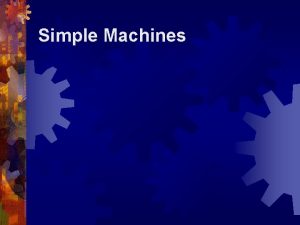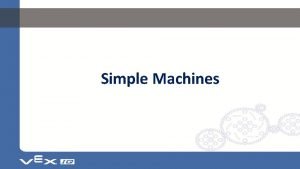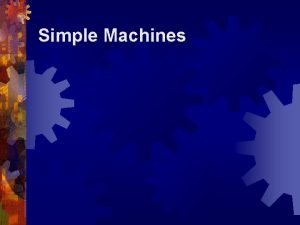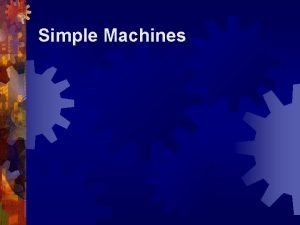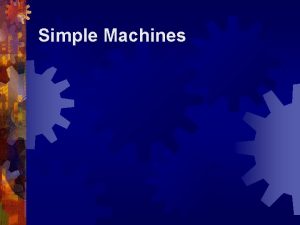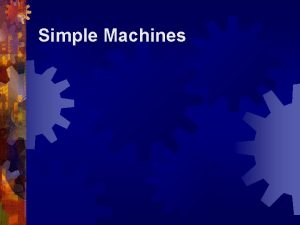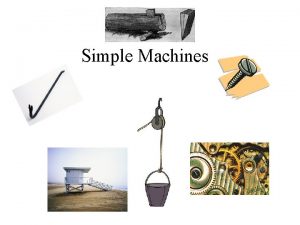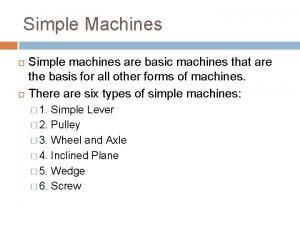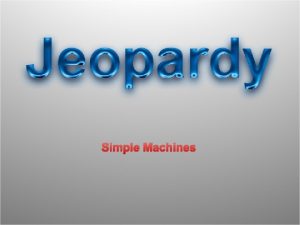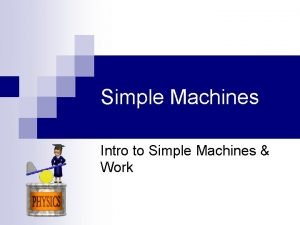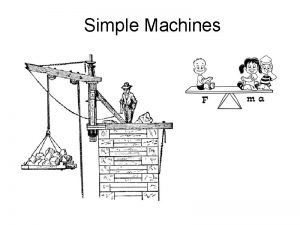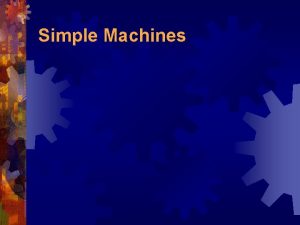Machines Ch 7 II The Simple Machines p

















- Slides: 17

Machines - Ch. 7 II. The Simple Machines (p. 180 -183) Lever t Inclined Plane t Pulley t Wheel & Axle t Screw t Wedge t

A. Lever u Lever l a bar that is free to pivot about a fixed point, or fulcrum Resistance arm Effort arm Fulcrum Engraving from Mechanics Magazine, London, 1824 “Give me a place to stand I will move the Earth. ” – Archimedes

A. Lever u Ideal Mechanical Advantage (IMA) l frictionless machine Effort arm length Resistance arm length l Le must be greater than Lr in order to multiply the force.

A. Lever u First Class Lever l can increase force, distance, or neither l changes direction of force

A. Lever u Second Class Lever l always increases force

A. Lever u Third Class Levers l always increases distance

B. Pulley u Pulley l grooved wheel with a rope or chain running along the groove l a “flexible first-class lever” F Le Lr

B. Pulley u Ideal Mechanical Advantage (IMA) l equal to the number of supporting ropes IMA = 0 IMA = 1 IMA = 2

B. Pulley u Fixed Pulley l IMA =1 l does not increase force l changes direction of force

B. Pulley u Movable Pulley IMA = 2 l increases force l doesn’t change direction l

B. Pulley u Block & Tackle l l l combination of fixed & movable pulleys increases force (IMA = 4) may or may not change direction

C. Wheel and Axle u Wheel and Axle l two wheels of different sizes that rotate together l a pair of Wheel “rotating levers” Axle

C. Wheel and Axle u Ideal Mechanical Advantage (IMA) l l effort force is usu. applied to wheel axle moves less distance but with greater force effort radius resistance radius

Problems u You use a 160 cm plank to lift a large rock. If the rock is 20 cm from the fulcrum, what is the plank’s IMA? GIVEN: WORK: Lr = 20 cm Le = 140 cm IMA = ? Le IMA = Le ÷ Lr IMA = (140 cm) ÷ (20 cm) IMA = 7 20 cm IMA Lr 160 cm

Problems u A crank on a pasta maker has a radius of 20 cm. The turning shaft has a radius of 5 cm. What is the IMA of this wheel and axle? GIVEN: WORK: re = 20 cm rr = 5 cm IMA = ? IMA = re ÷ rr IMA = (20 cm) ÷ (5 cm) IMA = 4 re IMA 5 cm 20 cm rr

Problems u A steering wheel requires a mechanical advantage of 6. What radius does the wheel need to have if the steering column has a radius of 4 cm? GIVEN: WORK: IMA = 6 re = ? rr = 4 cm re = IMA · rr re = (6)(4 cm) re = 24 cm re IMA rr rr re

Problems u You need to lift a 150 N box using only 15 N of force. How long does the lever need to be if the resistance arm is 0. 3 m? GIVEN: WORK: Fr = 150 N Fe = 15 N Lr = 0. 3 m Le = ? MA = 10 Le = IMA · Lr 15 N Le = (10)(0. 3) Le = 3 m Total length = Le + Lr Total length = 3. 3 m 0. 3 m ? Le IMA 150 N Lr
 Hình ảnh bộ gõ cơ thể búng tay
Hình ảnh bộ gõ cơ thể búng tay Bổ thể
Bổ thể Tỉ lệ cơ thể trẻ em
Tỉ lệ cơ thể trẻ em Gấu đi như thế nào
Gấu đi như thế nào Chụp tư thế worms-breton
Chụp tư thế worms-breton Hát lên người ơi
Hát lên người ơi Các môn thể thao bắt đầu bằng tiếng chạy
Các môn thể thao bắt đầu bằng tiếng chạy Thế nào là hệ số cao nhất
Thế nào là hệ số cao nhất Các châu lục và đại dương trên thế giới
Các châu lục và đại dương trên thế giới Cong thức tính động năng
Cong thức tính động năng Trời xanh đây là của chúng ta thể thơ
Trời xanh đây là của chúng ta thể thơ Mật thư tọa độ 5x5
Mật thư tọa độ 5x5 Phép trừ bù
Phép trừ bù độ dài liên kết
độ dài liên kết Các châu lục và đại dương trên thế giới
Các châu lục và đại dương trên thế giới Thể thơ truyền thống
Thể thơ truyền thống Quá trình desamine hóa có thể tạo ra
Quá trình desamine hóa có thể tạo ra


















